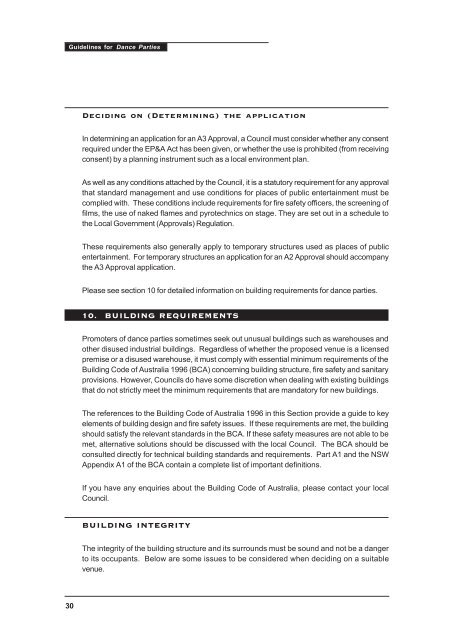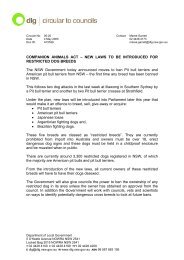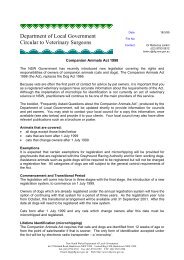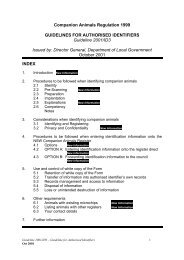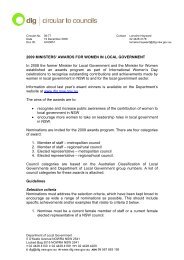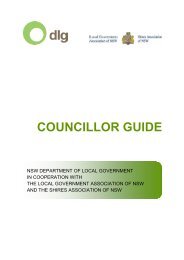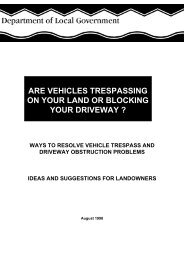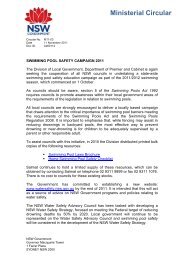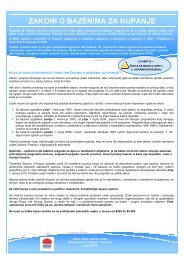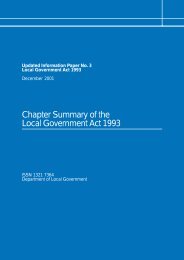Guidelines for Dance Parties - Division of Local Government - NSW ...
Guidelines for Dance Parties - Division of Local Government - NSW ...
Guidelines for Dance Parties - Division of Local Government - NSW ...
- No tags were found...
Create successful ePaper yourself
Turn your PDF publications into a flip-book with our unique Google optimized e-Paper software.
<strong>Guidelines</strong> <strong>for</strong> <strong>Dance</strong> <strong>Parties</strong>Deciding on (Determining) the applicationIn determining an application <strong>for</strong> an A3 Approval, a Council must consider whether any consentrequired under the EP&A Act has been given, or whether the use is prohibited (from receivingconsent) by a planning instrument such as a local environment plan.As well as any conditions attached by the Council, it is a statutory requirement <strong>for</strong> any approvalthat standard management and use conditions <strong>for</strong> places <strong>of</strong> public entertainment must becomplied with. These conditions include requirements <strong>for</strong> fire safety <strong>of</strong>ficers, the screening <strong>of</strong>films, the use <strong>of</strong> naked flames and pyrotechnics on stage. They are set out in a schedule tothe <strong>Local</strong> <strong>Government</strong> (Approvals) Regulation.These requirements also generally apply to temporary structures used as places <strong>of</strong> publicentertainment. For temporary structures an application <strong>for</strong> an A2 Approval should accompanythe A3 Approval application.Please see section 10 <strong>for</strong> detailed in<strong>for</strong>mation on building requirements <strong>for</strong> dance parties.10. BUILDING REQUIREMENTSPromoters <strong>of</strong> dance parties sometimes seek out unusual buildings such as warehouses andother disused industrial buildings. Regardless <strong>of</strong> whether the proposed venue is a licensedpremise or a disused warehouse, it must comply with essential minimum requirements <strong>of</strong> theBuilding Code <strong>of</strong> Australia 1996 (BCA) concerning building structure, fire safety and sanitaryprovisions. However, Councils do have some discretion when dealing with existing buildingsthat do not strictly meet the minimum requirements that are mandatory <strong>for</strong> new buildings.The references to the Building Code <strong>of</strong> Australia 1996 in this Section provide a guide to keyelements <strong>of</strong> building design and fire safety issues. If these requirements are met, the buildingshould satisfy the relevant standards in the BCA. If these safety measures are not able to bemet, alternative solutions should be discussed with the local Council. The BCA should beconsulted directly <strong>for</strong> technical building standards and requirements. Part A1 and the <strong>NSW</strong>Appendix A1 <strong>of</strong> the BCA contain a complete list <strong>of</strong> important definitions.If you have any enquiries about the Building Code <strong>of</strong> Australia, please contact your localCouncil.BUILDING INTEGRITYThe integrity <strong>of</strong> the building structure and its surrounds must be sound and not be a dangerto its occupants. Below are some issues to be considered when deciding on a suitablevenue.30


